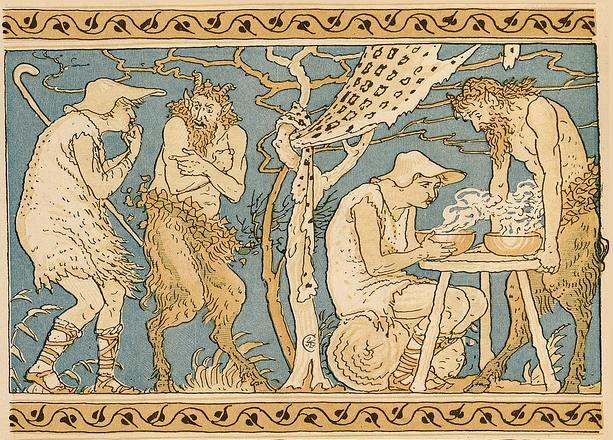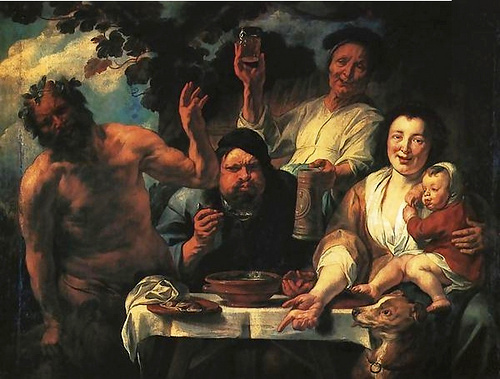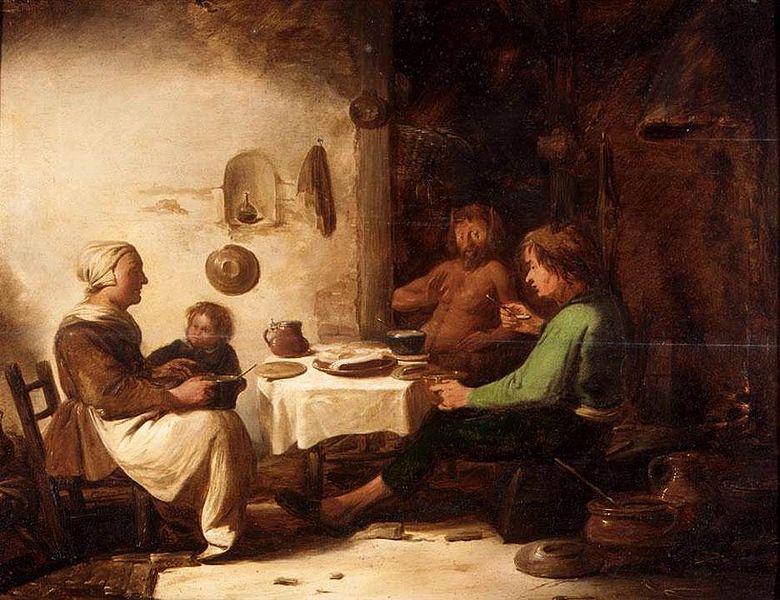The Satyr and the Traveller (or Peasant) is one of Aesop's Fables and is numbered 35 in the Perry Index. The popular idiom 'to blow hot and cold' is associated with it.

Ioannis Patousas
Collection of Aesop's Fables in Greek, Venice
The Satyr and the Peasant, c. 1644
There are Greek versions and a late Latin version of the fable by Avianus. In its usual form, a satyr or faun comes across a traveller wandering in the forest in deep winter. Taking pity on him, the satyr invites him home. When the man blows on his fingers, the satyr asks him what he is doing and is impressed when told that he can warm them that way. But when the man blows on his soup and tells the satyr that this is to cool it, the honest woodland creature is appalled at such double dealing and drives the traveller from his cave. There is an alternative version in which a friendship between the two is ended by this behaviour.

Walter Crane
The Satyr and the Peasant, c. 1887
Crane's work featured some of the more colourful and detailed beginnings of the child-in-the-garden motifs that would characterize many nursery rhymes and children's stories for decades to come. He was part of the Arts and Crafts movement and produced an array of paintings, illustrations, children's books, ceramic tiles and other decorative arts. Crane is also remembered for his creation of a number of iconic images associated with the international Socialist movement. More
CRE NEEFS, Jacques; ( Flemish; 1610-1660)
The Satyr Visiting The Peasant Family
Engraving, printed in black ink
38.9 x 40
CRE NEEFS, Jacques; ( Flemish; 1610-1660) AFTER JORDAENS, Jacob; (Flemish; 1593-1678)
The idiom 'to blow hot and cold (with the same breath)', was defined by the emblem books of the Renaissance, particularly those that focused on fables as providing lessons for moral conduct. While Hieronymus Osius tells the tale of the traveller and draws the moral that one should avoid those who are inconstant, Gabriele Faerno puts it in the context of friendship and counsels that this should be avoided with the 'double-tongued' (bilingues). In this he is followed by Giovanni Maria Verdizotti, Marcus Gheeraerts the Elder and Geoffrey Whitney. However, in Francis Barlow's edition of the fables (1687), the Latin text warns against those whose heart and tongue do not accord

Jan van der Venne (fl. 1616–1651)
De satyr bij de boer, first half of 17th century
Oil on panel
38 × 54 cm (15 × 21.3 in)
Brukenthal National Museum, Romania
Jan van de Venne (active by 1616 – died before 1651), was a Flemish painter of genre, religious scenes, and cabinets who was court painter to the governors of the Southern Netherlands. Many of his works depict "low-life" genre scenes of tooth-pullers, card-players and hurdy-gurdy players, tronies and expressive religious scenes. More
The fable was included as Le satyre et le passant among the fables of Jean de la Fontaine (V.7) but with no alteration of moral. However, this version too was to be reinterpreted in a political sense in the 19th century. In the course of his very free version, John Matthews expanded the text to comment on the 1819 election in Westminster and advise the voters to adopt the satyr's view of blowing hot and cold. In France the satirical cartoonist J.J. Grandville also updated the meaning by showing a group of loungers reading and commenting on the newspapers in a public park next to a statue illustrating the fable.

Sebastiano Ricci
The Satyr and the Traveller, Early 18th century
The Louvre
Sebastiano Ricci (1 August 1659 – 15 May 1734) was an Italian painter of the late Baroque school of Venice. About the same age as Piazzetta, and an elder contemporary of Tiepolo, he represents a late version of the vigorous and luminous Cortonesque style of grand manner fresco painting. More
The Age of Enlightenment had intervened and prominent thinkers had then attacked the logic of this fable in particular. In the article on "Fable" in his Dictionnaire Philosophique (1764), Voltaire remarked that the man was quite right in his method of warming his fingers and cooling his soup, and the satyr was a fool to take exception.[ The German philosopher Gotthold Ephraim Lessing asserts in one of his essays on fables that its fault 'lies not in the inaccuracy of the allegory, but that it is an allegory only', perhaps reaching towards the conclusion that the fable had been badly framed around an already existing proverb. 'The man ought really to have acted contradictorily; but in this fable he is only supposed to have done so.' By using the fable to focus on political behaviour, therefore, the writers and artists give it a justification not inherent within its narrative.

Constantijn à Renesse (1626 – 1680)
Satyr at the peasant's house, c. 1653
Oil on canvas
168 × 203 cm (66.1 × 79.9 in)
National Museum in Warsaw, Poland
Constantijn à Renesse (1626 – 1680), was a Dutch Golden Age painter and pupil of Rembrandt. He was born in Maarssen to the son of Frederick Henry, Prince of Orange's military chaplain. He moved with his family to Breda and was sent to Leiden to the University, where besides literature studies he also took drawing lessons from Rembrandt in 1649. He moved to Eindhoven in 1653 where he later died. He is known for religious prints and drawings and is documented working with Rembrandt on paintings of religious subjects. More

Hippolyte Lecomte
Le satyre et le passant
1818 edition of La Fontaine's Fables
Hippolyte Lecomte (28 December 1781, Puiseaux – 25 July 1857, Paris) was a French painter best known for large scale historical paintings and ballet designs. His wife, born Camille Vernet, was the sister of the painter Émile Jean-Horace Vernet; the caricaturist Jean Ignace Isidore Gérard, better known as "J.J. Grandville", worked in Lecomte's studio (See Below). His son, Charles Emile Hippolyte Lecomte-Vernet, was also a noted painter. More

Jean Ignace Isidore Gérard (1803–1847)
J.J. Grandville's reinterpretation of La Fontaine's Fable of "Le Satyr et le Passant", c. 1838
The success of this work led to his being engaged as artistic contributor to various periodicals, such as La Silhouette, L'Artiste, La Caricature, Le Charivari; and his political caricatures which were characterized by marvelous fertility of satirical humour, soon came to enjoy a general popularity.
After the reinstitution of prior censorship of caricature in 1835, Grandville turned almost exclusively to book illustration, supplying illustrations for various standard works, such as the songs of Béranger, the fables of La Fontaine, Don Quixote, Gulliver's Travels, Robinson Crusoe. He also continued to issue various lithographic collections, among which may be mentioned La Vie privée et publique des animaux, Les Cent Proverbes, Un Autre Monde and Les Fleurs animées.
Though the designs of Grandville are occasionally unnatural and absurd, they usually display keen analysis of character and marvellous inventive ingenuity, and his humour is always tempered and refined by delicacy of sentiment and a vein of sober thoughtfulness. He died on 17 March 1847 and is buried in the Cimetière Nord of Saint-Mandé just outside Paris. More

Attributed to Sebastiano Ricci, BELLUNO 1659 - 1734 VENICE
A SCENE FROM AESOP'S FABLE: THE SATYR AND THE PEASANT
oil on canvas
24 1/8 by 27 7/8 in.; 61.2 by 71 cm
Sebastiano Ricci, see above
For a variety of reasons the fable of "The Satyr and the Peasant" in particular became one of the most popular genre subjects in Europe and by some artists was painted in many versions. It was particularly popular in the Netherlands, where it brought together the contemporary taste for Classical mythology and a local liking for peasant subjects. At the start of the 17th century the poet Joost van den Vondel published his popular collection based on Marcus Gheeraerts' prints, Vorstelijke Warande der Dieren (Princely pleasure-ground of beasts, 1617), in which the poem Satyr en Boer appears.[12] This seems to have appealed to the imagination of the young Jacob Jordaens, who went on to produce some dozen versions of the subject and did more than any other painter to popularise it.[13] He was followed in his native Antwerp by others such as Willem van Herp and Jan Cossiers, while in the Northern Netherlands it was taken up by the group of Rembrandt's pupils and followers, Gerbrand van den Eeckhout, Barent Fabritius and Claes Corneliszoon Moeyaert, as well as by genre painters like Benjamin Gerritsz Cuyp, Jan Steen and David Ryckaert the younger.
Gerbrand van den Eeckhout (1621–1674)
The Satyr and the Peasant, c. mid 17th century
Gerbrand van den Eeckhout (19 August 1621 – 29 September 1674), was a Dutch Golden Age painter and a favourite student of Rembrandt. He was also an etcher, an amateur poet, a collector and an adviser on art. More

Jan Steen
Satyr and the Peasant Family, c.1660-62
Jan Havickszoon Steen (c. 1626 – buried 3 February
1679) was a Dutch genre painter of the 17th century (also known as
the Dutch Golden Age). His works are known for their psychological insight,
sense of humour and abundance of colour. Steen was born in Leiden, where his
well-to-do, Catholic family. He was the eldest of eight or more children. Like
his even more famous contemporary Rembrandt van Rijn, Jan Steen attended the
Latin school and became a student in Leiden. He received his painterly
education from Nicolaes Knupfer (1603–1660), a German painter of historical and
figurative scenes in Utrecht. Influences of Knupfer can be found in Steen's use
of composition and colour. Other sources of inspiration were Adriaen van Ostade
and Isaac van Ostade, painters of rural scenes, who lived in Haarlem. Whether
Steen actually studied with Ostade is not known.
In 1648
Jan Steen and Gabriël Metsu founded the painters' Guild of Saint Luke at
Leiden. Soon after he became an assistant to the renowned landscape painter Jan
van Goyen and moved into his house on the Bierkade in The Hague. On Oct 3, 1649
he married van Goyen's daughter Margriet, with whom he would have eight
children. Steen worked with his father-in-law until 1654, when he moved to
Delft, where he ran the brewery De Slang for three years without much
success.
Steen lived in Warmond, just north of Leiden, from 1656
till 1660 and in Haarlem from 1660 till 1670 and in both periods he was
especially productive. In 1670, after the death of his wife in 1669 and his
father in 1670, Steen moved back to Leiden, where he stayed the rest of his
life. When the art market collapsed in 1672, called the Year of Disaster, Steen
opened a tavern. In April 1673 he married Maria van Egmont, who gave him
another child. In 1674 he became president of the Saint Lucas Guild. Frans van
Mieris became one of his drinking companions. He died in Leiden in 1679 and was
interred in a family grave in the Pieterskerk. More
Johann Liss, German (c. 1597-1631)
The Satyr and the Peasant, c. 1623/1626
Oil on canvas
133.3 x 167.4 cm (52 1/2 x 65 7/8 in.)
National Gallery of Art, Washington, D.C.
Although his earlier work was concerned with the contrasts of light and shadow, his final move to Venice in the early 1620s modified his style and gave impetus to brilliant color and a spirited treatment of the painted surface. In 1627, he was created an admired large altarpiece, the Inspiration of Saint Jerome in San Nicolò da Tolentino. His loose brushstrokes seem precursor to rococo styles of the Guardi brothers.This final style, along with that of other "foreign" painters residing in Venice, Domenico Fetti and Bernardo Strozzi, represent the first inroads of Baroque style into the republic.
His legacy is as a painter of both sensuous mythological and pious biblical subjects, a master of colors and Baroque painting. He was most influential to Venetian 18th-century painters like Sebastiano Ricci, Giovanni Battista Tiepolo and Giovanni Piazzetta. More

Jacob Jordaens, 1593 - 1678
Satyr and Peasant
c. 1615
67 x 51 cm
Oil on canvas
Glasgow Life, Glasgow Museums
Aesop’s ancient fable warns against the double minded, and Jordaens’ earliest known version seeks to visualize this lesson in several ways at once. The figure of the satyr – half man, half beast – literally embodies the idea of man’s conflicting spiritual and animal urges. This theme is echoed by the two women: one is modestly dressed, her head covered; the other wears a low-cut blouse and flowers in her hair. They could almost be seen as homespun personifications of spiritual and earthly love, respectively. More
Jacob Jordaens (19 May 1593 – 18 October 1678) was a Flemish painter, draughtsman and tapestry designer known for his history paintings, genre scenes and portraits. After Peter Paul Rubens and Anthony van Dyck, he was the leading Flemish Baroque painter of his day. Unlike those contemporaries he never travelled abroad to study Italian painting, and his career is marked by an indifference to their intellectual and courtly aspirations. In fact, except for a few short trips to locations in the Low Countries, he remained in Antwerp his entire life. As well as being a successful painter, he was a prominent designer of tapestries. Like Rubens, Jordaens painted altarpieces, mythological, and allegorical scenes, and after 1640—the year Rubens died—he was the most important painter in Antwerp for large-scale commissions and the status of his patrons increased in general. However, he is best known today for his numerous large genre scenes based on proverbs in the manner of his contemporary Jan Brueghel the Elder, depicting The King Drinks and As the Old Sing, So Pipe the Young. Jordaens' main artistic influences, besides Rubens and the Brueghel family, were northern Italian painters such as Jacopo Bassano, Paolo Veronese, and Caravaggio. More
Jacob Jordaens, 1593 - 1678
THE SATYR AND THE PEASANT FAMILY
oil on canvas
46 1/2 by 59 1/4 in.; 118.2 by 150.5 cm
Jacob Jordaens, 1593 - 1678, see above

Jacob Jordaens, 1593 - 1678
The Satyr and the Peasant, c. 1620s
Pushkin Gallery, Moscow
Jacob Jordaens, 1593 - 1678, see above

Jacob Jordaens, 1593 - 1678
The Satyr and the Peasant
Musées Royaux des Beaux-Arts, Brussels
Jacob Jordaens, 1593 - 1678, see above

Jacob Jordaens, 1593 - 1678
Satyr at the Peasant's House
174 × 204 cm (68.5 × 80.3 in)
Alte Pinakothek, München, Germany
Jacob Jordaens, 1593 - 1678, see above

Jacob Jordaens (1593–1678)
The Satyr and the Peasant, c. 1640
Jacob Jordaens, 1593 - 1678, see above
Jacob Jordaens (1593–1678)
The Eating Man, c. 1640
Variant
Jacob Jordaens, 1593 - 1678, see above

Studio of Jacob Jordaens I (Antwerp 1593-1678)
Satyr and Peasant
oil on canvas, possibly transferred from panel
66¼ x 70 5/8 in. (168.2 x 179.4 cm.)
Jacob Jordaens, 1593 - 1678, see above
Willem van Herp (circa 1613/1614–1677)
The Satyr and the Peasant, circa 1650
Willem van Herp (1614–1677) was a Flemish Baroque painter specializing in religious paintings and small cabinet paintings of "low-life" genre scenes. For a long time Willem van Herp was believed to have been a pupil of Peter Paul Rubens. Even though he was not his pupil he did borrow many of Rubens' motifs and touched up copies after Rubens for the art dealer Matthijs Musson. He was listed as an independent master in the Guild of St. Luke beginning in 1637. He spent his entire career in Antwerp. He was the master of Norbertus van Herp and Melchior Hamers More

Benjamin Gerritsz Cuyp (1612–1652)
The Satyr and the Peasant Family, first half of 17th century
Oil on panel
Height: 58 cm (22.8 in). Width: 75 cm (29.5 in).
According to the RKD, Houbraken was mistaken about the family, and Benjamin and Jacob were both born in Dordrecht as the sons of a glasspainter from Venlo named Gerrit Gerritsz Cuyp. Benjamin learned to paint from his older half-brother, Jacob Gerritsz Cuyp. He was therefore the uncle, not the cousin, of the much more famous Aelbert Cuyp. He is known for allegorical pieces, genre works, beach scenes, military scenes, and landscapes. He influenced Barent van Kalraet, and was followed by Maerten Fransz van der Hulst. More

David Rijckaert (III) (1612–1661)
The fable of the satyr and the peasant family, c. 1650s
Oil on canvas
111.4 × 153.2 cm (43.9 × 60.3 in)
David Rijckaert III, (2 December 1612 (baptized), Antwerp - 11 November 1661, Antwerp) was a Flemish painter known for his contribution to genre painting, in particular through his scenes of merry companies and peasants. He enjoyed the patronage of prominent patrons and was a painter to the court of the governor of the Southern Netherlands. More
Barent Fabritius (1624–1673)
The Satyr and the Peasant, c. 17th century
Oil on Canvas
Musée des Beaux-Arts de Caen, France
Images are copyright of their respective owners, assignees or others
Acknowledgement: Wikipedia


Great resource and useful thank you!
ReplyDeleteThank you! And glad you enjoyed :)
Delete